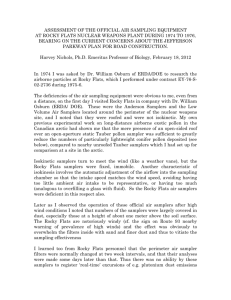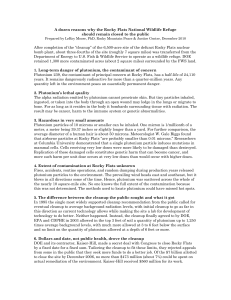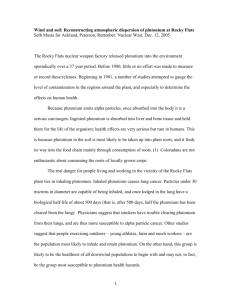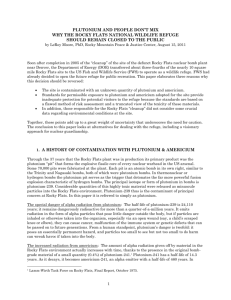Pu in soil standard=2-10 - Rocky Mountain Peace and Justice Center
advertisement
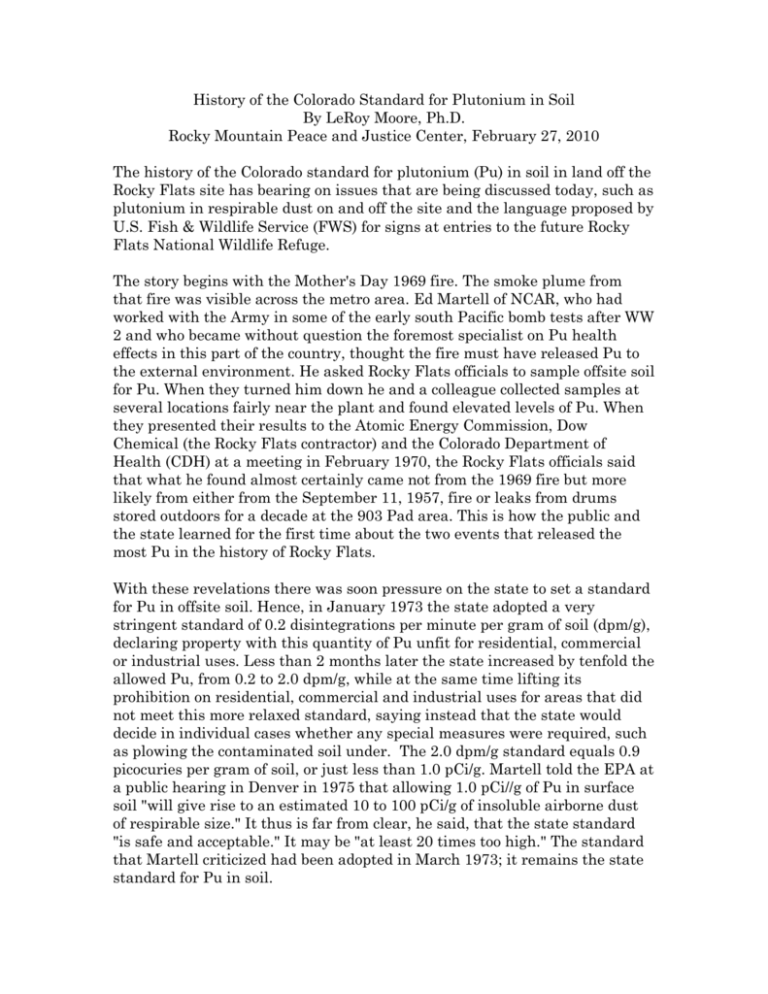
History of the Colorado Standard for Plutonium in Soil By LeRoy Moore, Ph.D. Rocky Mountain Peace and Justice Center, February 27, 2010 The history of the Colorado standard for plutonium (Pu) in soil in land off the Rocky Flats site has bearing on issues that are being discussed today, such as plutonium in respirable dust on and off the site and the language proposed by U.S. Fish & Wildlife Service (FWS) for signs at entries to the future Rocky Flats National Wildlife Refuge. The story begins with the Mother's Day 1969 fire. The smoke plume from that fire was visible across the metro area. Ed Martell of NCAR, who had worked with the Army in some of the early south Pacific bomb tests after WW 2 and who became without question the foremost specialist on Pu health effects in this part of the country, thought the fire must have released Pu to the external environment. He asked Rocky Flats officials to sample offsite soil for Pu. When they turned him down he and a colleague collected samples at several locations fairly near the plant and found elevated levels of Pu. When they presented their results to the Atomic Energy Commission, Dow Chemical (the Rocky Flats contractor) and the Colorado Department of Health (CDH) at a meeting in February 1970, the Rocky Flats officials said that what he found almost certainly came not from the 1969 fire but more likely from either from the September 11, 1957, fire or leaks from drums stored outdoors for a decade at the 903 Pad area. This is how the public and the state learned for the first time about the two events that released the most Pu in the history of Rocky Flats. With these revelations there was soon pressure on the state to set a standard for Pu in offsite soil. Hence, in January 1973 the state adopted a very stringent standard of 0.2 disintegrations per minute per gram of soil (dpm/g), declaring property with this quantity of Pu unfit for residential, commercial or industrial uses. Less than 2 months later the state increased by tenfold the allowed Pu, from 0.2 to 2.0 dpm/g, while at the same time lifting its prohibition on residential, commercial and industrial uses for areas that did not meet this more relaxed standard, saying instead that the state would decide in individual cases whether any special measures were required, such as plowing the contaminated soil under. The 2.0 dpm/g standard equals 0.9 picocuries per gram of soil, or just less than 1.0 pCi/g. Martell told the EPA at a public hearing in Denver in 1975 that allowing 1.0 pCi//g of Pu in surface soil "will give rise to an estimated 10 to 100 pCi/g of insoluble airborne dust of respirable size." It thus is far from clear, he said, that the state standard "is safe and acceptable." It may be "at least 20 times too high." The standard that Martell criticized had been adopted in March 1973; it remains the state standard for Pu in soil. Enter Carl Johnson. He became Director of the Jefferson County Health Department in Sept 1973, but he was not involved with RF until December 1974 when Jefferson County Commissioner Joanne Paterson sought his opinion on whether the commissioners should permit a new residential development on land just east and therefore downwind of Rocky Flats. CDH had already approved this project, despite finding Pu concentrations in soil in the area at up to seven times the state's standard; they would simply require that the soil be plowed under. In response to the query of Commissioner Paterson, Johnson recruited two USGS scientists and they initiated their innovative method of sampling respirable dust and testing it for Pu content. Taking 25 samples from the very same locations the state had sampled, they found Pu concentrations in dust on average 44 times greater than the state had measured with its whole soil sampling method. On getting these results the County Commissioners vetoed the residential development. Johnson and his colleagues published a report on their respirable dust sampling and its results in SCIENCE (6 August 1976). In October 1975 Johnson proposed that the state set a new standard for Pu in surface soil based on its content in respirable dust. The state sought the advice of Karl Morgan, "father of health physics" and recently retired from the Oak Ridge National Lab. Morgan urged the state to adopt Johnson's respirable dust sampling method because it would produce more accurate results and would be more protective of the public health. Having gotten the advice they sought, state officials rejected it and stayed with their whole-soil sampling method. Eventually the state standardized their method, collecting the top quarter inch of soil. Having stopped a housing development with the respirable dust study, Johnson continued over a relatively brief period to produce a series of studies about public health effects from radionuclides in the environment around the Rocky Flats Plant. Real estate interests gained control of the Jefferson County Commissioners and in May 1981 had Johnson forced out of his job. As a result of the post-1969-fire revelations about contamination downwind of Rocky Flats, the owners of the Church Ranch property sued the federal government for damages to their property. This case was finally settled out of court in December 1984. One piece of the settlement was that the state gave owners of the Church land a certificate stating that Pu contamination on their land did not exceed the state standard (the very land on which earlier the state had found Pu concentrations up to seven times the state standard). A resident of Jefferson County told me recently that the very residential project that had previously been vetoed due to Johnson's respirable dust study was subsequently built, so that people now live on the land in question. All this is background to what today is foreground. The state does have a standard for Pu in offsite soil, so, as the FWS sign language says, in fact there probably is very little difference between Pu concentrations in soil on the site on the west side of Indiana St. and off the site on the east side, etc. The monitoring now being done at Rocky Flats will not detect respirable dust. In the whole history of Rocky Flats there's never been any systematic practice of this kind of sampling. Both Harvey Nichols and Gale Biggs show, from different perspectives, that the air monitoring of the past was quite ineffective at detecting what was actually airborne at that time, that the results from such sampling were reassuring rather than realistic. This is because the tiniest particles of Pu, the ones most likely to be inhaled or otherwise taken into the body, were unlikely to be detected by the monitors in use. I have come to the conclusion that for air monitoring of Pu to be accurate, the monitors would have to be omnipresent, which is impossible, and omniscient, in the sense of actually capturing all particles and making it possible to derive from realistic data from what is captured, another impossibility because capturing the tiniest particles is like capturing smoke. The Rocky Flats Cleanup Agreement is predicated on the assumption that Pu remaining in the soil at Rocky Flats is "relatively immobile." But the agencies responsible for the cleanup never considered the findings of ecologist Shawn Smallwood, who in 1996 found 18 species of burrowing animals on the Rocky Flats site. These creatures, each in its own way, burrow down, some to as much as 16 feet, and constantly redistribute whatever is in the soil. Even deeply buried Pu particles are likely at some wholly unpredictable time to be brought to the surface, whether in the former industrial zone or the buffer zone. It hardly matters where the stuff surfaces; particles on the surface can be readily transported hither and yon by the winds at the site, which is why they present such a hazard to potential visitors to the refuge. This is the situation we have at Rocky Flats, which of course is why the site should never be opened for public recreation and why there should be a permanent program of testing respirable dust for its Pu (and Am) content. If the refuge is ever opened to the public, there needs to be a program of genuine, not vague, informed consent. I applaud Wes McKinley for at least making the attempt to get this. This bit of history is important for understanding how we got to where we are as these words are written in February 2010. (Documentation for what is written here can be found at Plutonium & People Don’t Mix at http://www.rockyflatsnuclearguardianship.org/leroy-moores-blog/papers-by-leroy-moore-phd-2/

![Sampling request to cities_web site[1]](http://s3.studylib.net/store/data/007176011_1-0a818a5303539813bd657308f066abc1-300x300.png)





